ikfoundation.org
Promoting Natural & Cultural History





RESEARCH AREA
FORLANDSØYANE AND PRINS KARLS FORLAND
ON SPITSBERGEN, SVALBARD
Along the northernmost point of Prins Karls Forland stretches a high mountain range in contrast to the low-lying Forlandsletta situated south of this area. Other geographical characteristics for this group of islands along the warm west-Spitsbergen stream are bird mountains and flat beaches on the western side of Forlandet, whilst the eastern side has steep glaciers and glacial fronts. Winds and currents during the time of sail included close-by encounters of the islands – situated along the west coast of Spitsbergen – quite usual in the summer months during hundreds of years. Bays and the waters facing the main island also gave a natural protection for ships during difficult weather conditions.

The southwestern coast of Prins Karls Forland. Photo: Andreas Nord | Bridge Builder Expeditions Spitsbergen, Voyage II, 2017.
EARLY VISITORS
The physician and naturalist Friderich Martens made the first known brief natural history descriptions of “Voerlande” in his book published in 1675, four years after his voyage on a whaling ship. An interesting selection of drawings are also included in this pioneering work, but he was not the first observer of this group of islands, going under a multitude of names due to visitors from various countries. Willem Barentsz mapped the peninsula in 1596, Henry Hudson passed the northern point of the main island in 1607, Jonas Poole was the first to document a landing in 1610 and the first map including “Prince Charles Foreland” was drawn by the Dutch cartographer Hessel Gerrits, via information obtained from an English whaler named Robert Fotherby.
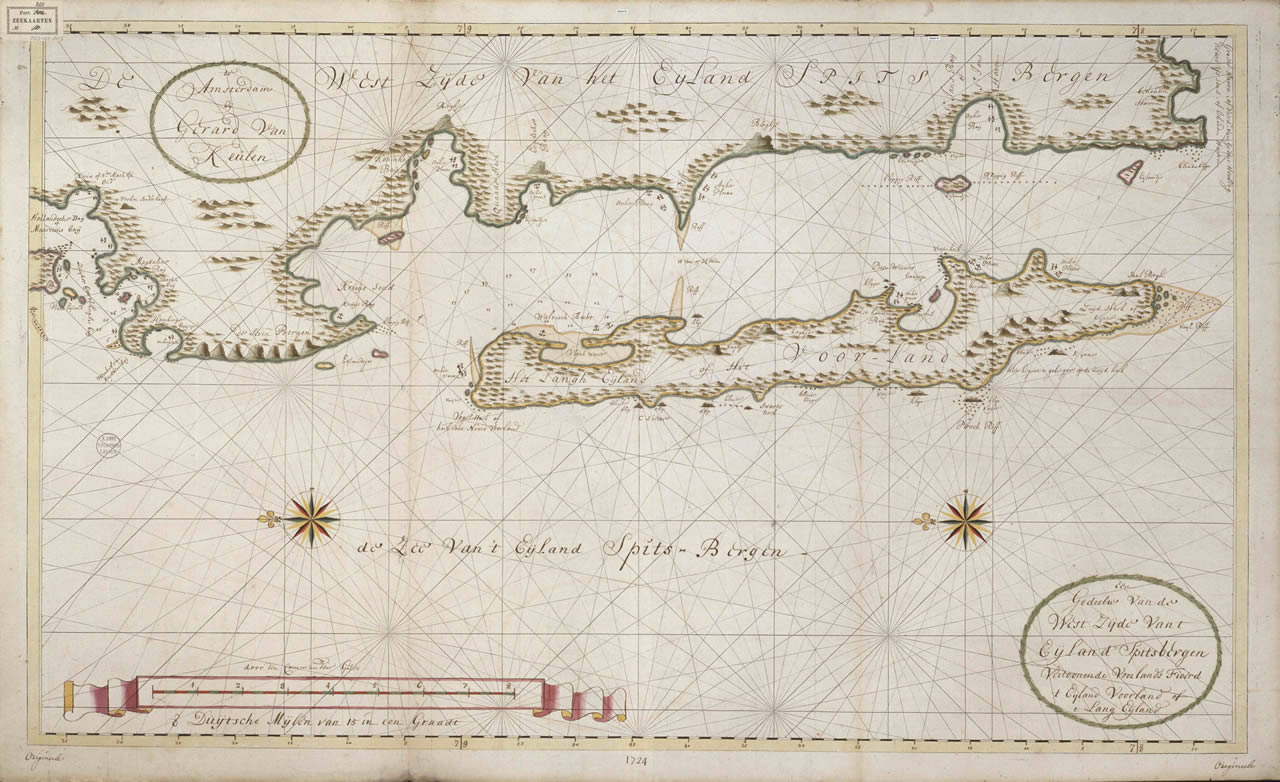
Chart of the coast of Prins Karls Forland, by Gerard Van Keülen in 1724. ”Ein Gedeelte Van de West Zÿde Vant Eÿland Spitsbergen Vertoonende Voorlands Fioird Eÿland Voorland of Lang Eÿland”
On the 1st July in 1758, the Swedish naturalist Anton Rolandsson Martin as one of Carl Linnaeus’ so-called Apostles aboard a whaling ship, made the first known and documented scientific investigation of Forlandsøyane. He got ashore and studied the landscape for a few hours only, but even so managed to make observations/drawings of the climate, fauna, flora and collect a rock specimen and some botanical samples. First 60 years later William Scoresby the Younger mentioned a landing on Forlandet in his journal 1818, whilst a more regular interest in the area was introduced in the 1860s. Some of these expeditions included: Elling Carlsen who made a landing in 1863, Richard von Drasche-Wartinberg ten years later, Alfred Nathorst made a brief visit in 1898, William Spears Bruce did several longer scientific investigations in the area between 1906 to 1920 and D.J. Atkinson & R.A McDonald performed detailed topographic and geological surveys, during three summers from 1950 to 1953.
PROTECTED WILDERNESS
Even in present-day, Prins Karls Forland and Forlandsøyane are only visited by a limited number of individuals – interested in the areas great variety of bird life, Arctic flora, rich maritime life, glaciers or geological formations. The uninhabited Prins Karls Forland has a diverse landscape, from alpine peaks over 1000 meters high, hilly topography to flat land and is part of the north Arctic tundra zone.
Forlandet National Park. The national park covers the entire island of Prins Karls Forland.
Since 1973 the entire island and surrounding sea area is protected as – Forlandet National Park – due to its unique and multi-facetted natural environments including ten Arctic lagoons giving advantages for biological multiplicity, as well as cultural history dating back to the earliest archeological finds of Russian and Norwegian whale hunters who stayed in huts over winter. The bird sanctuary and wetland on the island have also been recognised of international importance under the Ramsar Convention. Common eiders, black guillemots and barnacle geese being some of the breeding bird populations. Breeding grounds for seals and walruses are also of great significance in the archipelago just as the estimated population of 450 reindeers. The biological values of this protected landscape further includes its Arctic flora with species as arctic wood-rush (Luzula nivalis), solitary graminoid herb (Deschampsia alpina) and reindeer lichen (Cladonia stygia). These plants and many more of the luxuriant vegetation was for instance already researched by William Spears Bruce’s polar expedition during the summers of 1906 and 1907, giving invaluable knowledge for future preservation of the area.
GEOGRAPHICAL RESEARCH / MONITORING AREAS
Just opposite the two most northerly and largest of Forlandsøyane – Midtøya and Nordøya – by the west coast of Forlandsletta, will the centre [LAT: 78.363333 LON: 11.614458] for Field Station | Naturae Observatio | Martin's Eye be situated. From a raising of roughly 8 metres above sea level in the otherwise very level landscape. Via this location there are favourable possibilities for observations in all points of directions, biotopes and types of landscape alike. The project has been divided into three approximate geographical research areas, including the following scientific course of studies.
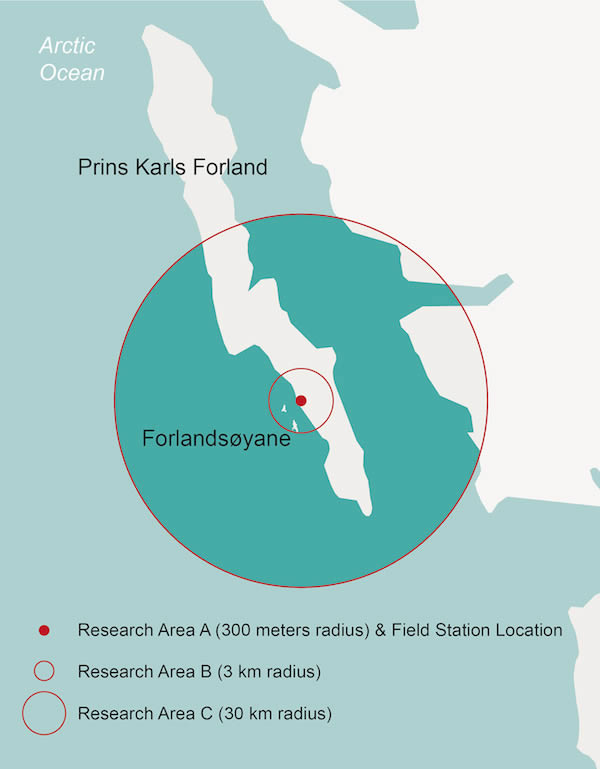
- Area A: 300 metres radius and Field Station location. The observation area includes a low cliff coast with parts of sandy beaches and wetland – giving a multitude of possibilities for detailed studies of fauna and flora as well as micro-meteorology and -hydrology. Observation data: Pictures, sound (in particular for records of the bird community), meteorological data and thermography & infrared-light monitoring of mammals and birds.
- Area B: 3 km radius. Within this area of observation, besides the same terrain as in Area A, the two Forlandsøyane, Midtøya and Nordøya are also situated, which both are classified as special Ramsar bird sanctuaries. The surrounding seas are shallow and rich in nutrients. In an easterly direction, the level landscape of Forlandsletta extends with its characteristic geology and wetlands. This area gives unique possibilities for detailed studies of fauna and flora as well as micro-meteorology and -hydrology. Observation data: Pictures (in particular long-term panoramic studies and recording of birds at Forlandsøyane) and meteorological data.
- Area C: 30 km radius. Within this largest area, besides the same terrain as in Area A and B, mountain and glacier areas are also situated in north, south and east of Forlandssundet, but also the coastal districts along the west coast of Forlandet and in an easterly direction off the open sea areas around Låglandsflaket. Observations from Area C provide Area A and B with important and additional data over weather systems of the entire area as well as changes of the seasons over both sea and land. Of particular interest is to fullfil long-term observations of the dynamic effect between land and seas, between the low-lying land and the mountainous areas and their glaciers. Observation data: Pictures (in particular long-term panoramic studies), meteorological data and documentation of Aurorae and Ooort-cloud comets.
Shooting direction: Wide-angle. Field Station | Naturae Observatio | Martin's Eye (work in progress, subject for local permission) | Photographed from the project's core, showing the area of the landscape within the interdisciplinary research project: Bridge Builder Expeditions Spitsbergen. PHOTO: Lars Hansen | Bridge Builder Expeditions Spitsbergen, Voyage II | iLinnaeus.org | September 9, 2017 | Elevation: approx: 8,4 m. | Time: 10.20 AM | Lat: 78.363333 Lon: 11.614458
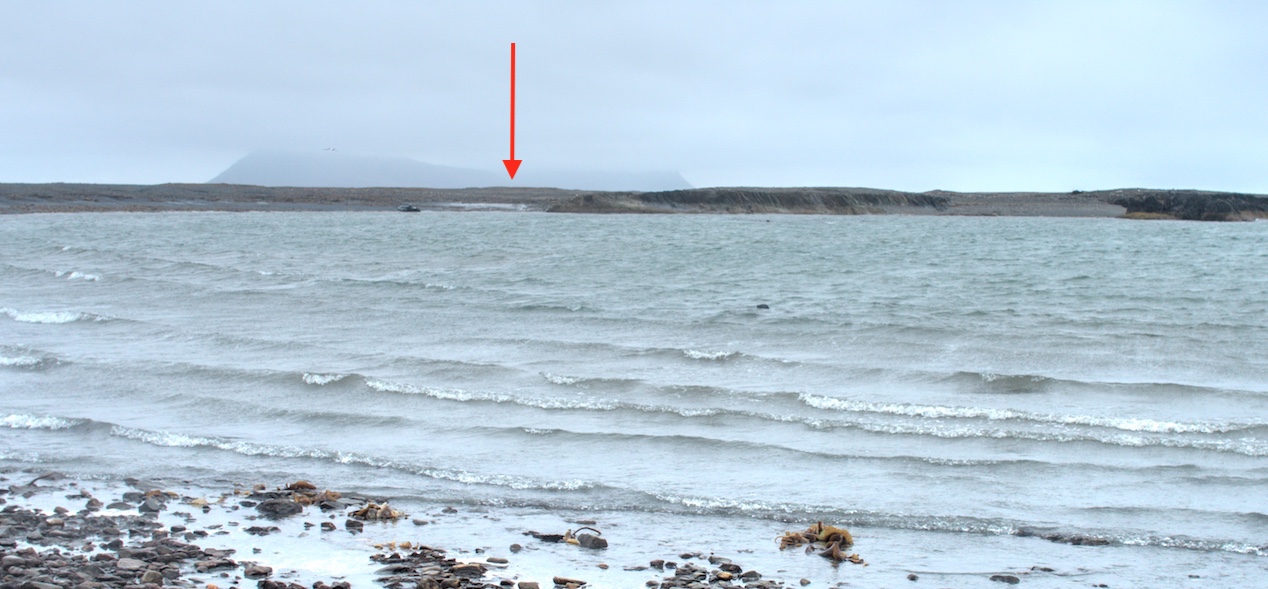
The selected low plateau for the placement of the Field Station. PHOTO: Lars Hansen | Bridge Builder Expeditions Spitsbergen, Voyage II | iLinnaeus.org | September 9, 2017.
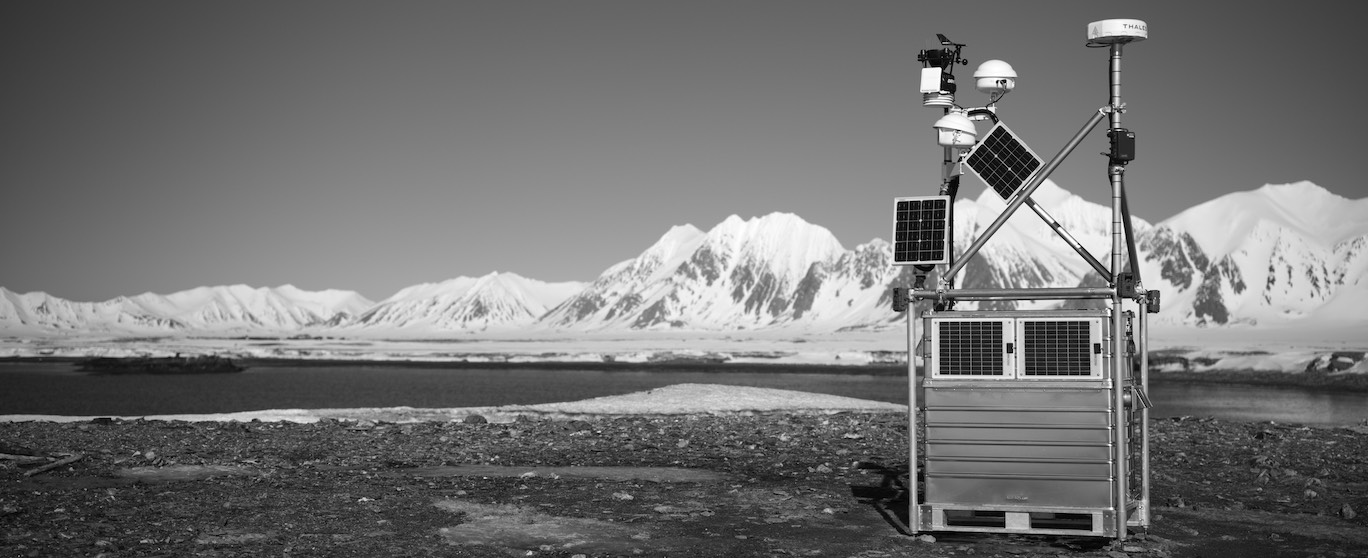
The Field Station | Naturae Observatio | Martin's Eye: from 12 May in 2019 working all round the clock – to make an insight into pure wilderness. Read more in the Initial Field Report. PHOTO: Lars Hansen | Bridge Builder Expeditions Spitsbergen, Voyage IV.A, 2019.
FIELD
STATION
NATURAE OBSERVATIO
The IK Foundation has taken the initiative to develop the next generation of scientific Field Stations. The work with FIELD STATION | NATURAE OBSERVATIO is a long-term project, a practical and theoretical enterprise - and part of the BRIDGE BUILDER EXPEDITIONS - aiming to establish eco-designed autonomous Field Stations, which unattended during night and day, all year-round will observe a selected landscape and its life.
The observations - as well as the designs and structures of stations vary – but is always an interdisciplinary resource to document nature and the environment during a predetermined period of time between one to three years.
For regular updates, we recommend fellowship by subscribing to our monthly newsletter iMESSENGER.
The observations - as well as the designs and structures of stations vary – but is always an interdisciplinary resource to document nature and the environment during a predetermined period of time between one to three years.
For regular updates, we recommend fellowship by subscribing to our monthly newsletter iMESSENGER.
PATRONAGE
This site/project
has been made globally available in collaboration with:
 Feel welcome to read more about how to take part...
Feel welcome to read more about how to take part...
 Feel welcome to read more about how to take part...
Feel welcome to read more about how to take part...
LINKS | FURTHER READING

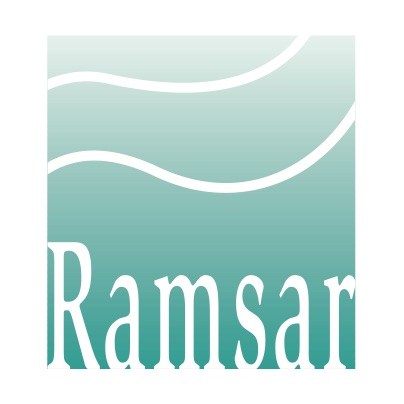
- BRIDGE BUILDER EXPEDITIONS SPITSBERGEN
- Research in Svalbard (RIS)
- RIS-ID 10275 (Bridge Builder Expeditions Spitsbergen)
- RIS-ID 11055 (Field Station Research Projects)
- The Norwegian Polar Institute's topographical Svalbard map portal
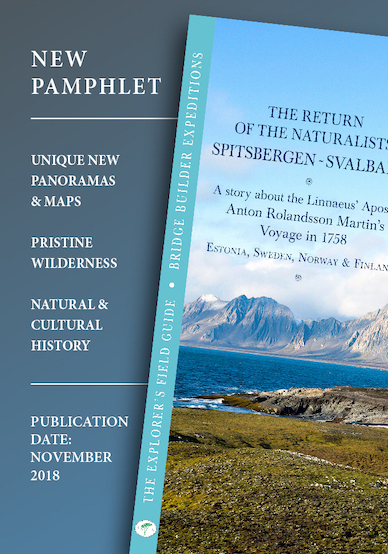


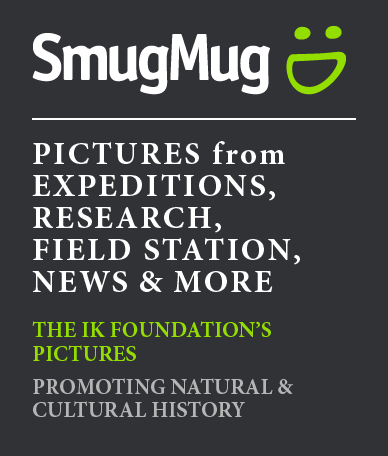
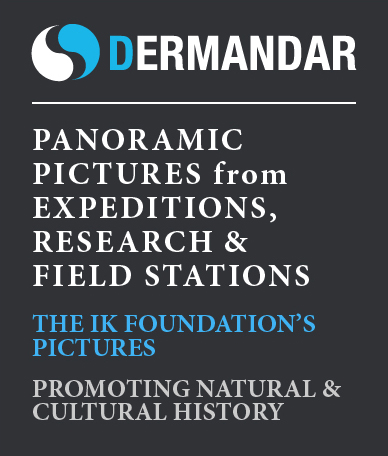

PROJECT GOVERNING
Lars Hansen | The IK FoundationArne Ardeberg | The IK Foundation
PRINCIPAL REFERENCES & RESOURCES
• The IK Foundation Mission Control Centre | Lars Hansen, Jeff Snoxell, Graham Scott • The Governor of Svalbard | Paul Lutnæs, Morten Wedege • LMK-stiftelsen | Foundation for Interdisciplinary Scientific Research | Malin Ferhm • Research & Reception Desk Office at The IK Foundation | Arne Ardeberg, Jennie Asher, Viveka Hansen, Leo RyderSee also LIST OF PARTICIPATORS
Updated/Checked 09/02/2023
THE IK FOUNDATION & COMPANY PROMOTING NATURAL & CULTURAL HISTORY
SUBSCRIBE TO OUR NEWSLETTER
TRANSLATE PAGE
A link to this page has
been copied to your clipboard
SHARE @been copied to your clipboard




© The IK Foundation & Company 2025
– a truly European organisation since 1988
– a truly European organisation since 1988
Legal issues | Forget me | and much more...
Home > FIELD STATION | NATURAE OBSERVATIO > Research Area


 FIELD STATION OVERVIEW
FIELD STATION OVERVIEW




